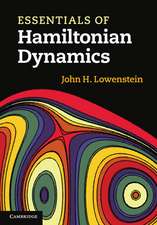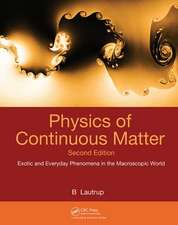Elastoplasticity Theory: Lecture Notes in Applied and Computational Mechanics, cartea 69
Autor Koichi Hashiguchien Limba Engleză Paperback – 18 sep 2015
The distinguishable features and importance of this book is the comprehensive description of fundamental concepts and formulations including the objectivity of
tensor and constitutive equations, the objective time-derivative of tensor functions, the associated flow rule, the loading criterion, the continuity and smoothness conditions and their substantial physical interpretations in addition to the wide classes of reversible/irreversible constitutive equations of solids and friction behavior between solids.
| Toate formatele și edițiile | Preț | Express |
|---|---|---|
| Paperback (2) | 844.13 lei 43-57 zile | |
| Springer Berlin, Heidelberg – 18 sep 2015 | 844.13 lei 43-57 zile | |
| Springer Berlin, Heidelberg – 22 oct 2010 | 1326.77 lei 43-57 zile |
Din seria Lecture Notes in Applied and Computational Mechanics
- 19%
 Preț: 422.95 lei
Preț: 422.95 lei - 18%
 Preț: 1008.12 lei
Preț: 1008.12 lei - 18%
 Preț: 1120.18 lei
Preț: 1120.18 lei - 20%
 Preț: 560.82 lei
Preț: 560.82 lei - 18%
 Preț: 948.16 lei
Preț: 948.16 lei - 24%
 Preț: 1567.86 lei
Preț: 1567.86 lei - 15%
 Preț: 643.65 lei
Preț: 643.65 lei - 18%
 Preț: 956.81 lei
Preț: 956.81 lei - 18%
 Preț: 957.62 lei
Preț: 957.62 lei - 15%
 Preț: 649.87 lei
Preț: 649.87 lei - 18%
 Preț: 1224.54 lei
Preț: 1224.54 lei - 18%
 Preț: 956.50 lei
Preț: 956.50 lei - 18%
 Preț: 954.45 lei
Preț: 954.45 lei - 18%
 Preț: 948.92 lei
Preț: 948.92 lei - 18%
 Preț: 949.55 lei
Preț: 949.55 lei - 15%
 Preț: 644.49 lei
Preț: 644.49 lei - 18%
 Preț: 1234.62 lei
Preț: 1234.62 lei - 18%
 Preț: 777.69 lei
Preț: 777.69 lei - 18%
 Preț: 1221.83 lei
Preț: 1221.83 lei - 15%
 Preț: 643.00 lei
Preț: 643.00 lei - 18%
 Preț: 956.33 lei
Preț: 956.33 lei - 15%
 Preț: 640.88 lei
Preț: 640.88 lei - 15%
 Preț: 645.79 lei
Preț: 645.79 lei - 18%
 Preț: 944.99 lei
Preț: 944.99 lei - 18%
 Preț: 956.18 lei
Preț: 956.18 lei - 18%
 Preț: 1236.69 lei
Preț: 1236.69 lei - 18%
 Preț: 953.97 lei
Preț: 953.97 lei - 15%
 Preț: 640.88 lei
Preț: 640.88 lei
Preț: 844.13 lei
Preț vechi: 1029.42 lei
-18% Nou
Puncte Express: 1266
Preț estimativ în valută:
161.55€ • 168.03$ • 133.36£
161.55€ • 168.03$ • 133.36£
Carte tipărită la comandă
Livrare economică 14-28 aprilie
Preluare comenzi: 021 569.72.76
Specificații
ISBN-13: 9783642426551
ISBN-10: 3642426557
Pagini: 476
Ilustrații: XVIII, 455 p.
Dimensiuni: 155 x 235 x 24 mm
Greutate: 0.66 kg
Ediția:Softcover reprint of the original 2nd ed. 2014
Editura: Springer Berlin, Heidelberg
Colecția Springer
Seria Lecture Notes in Applied and Computational Mechanics
Locul publicării:Berlin, Heidelberg, Germany
ISBN-10: 3642426557
Pagini: 476
Ilustrații: XVIII, 455 p.
Dimensiuni: 155 x 235 x 24 mm
Greutate: 0.66 kg
Ediția:Softcover reprint of the original 2nd ed. 2014
Editura: Springer Berlin, Heidelberg
Colecția Springer
Seria Lecture Notes in Applied and Computational Mechanics
Locul publicării:Berlin, Heidelberg, Germany
Cuprins
Tensor Analysis.- Motion and Strain (rate).- Conservation Laws and Stress Tensors.- Objectivity and Objective and Corotational Rate Tensors.- Elastic Constitutive Equations.- Basic Formulations for Elastoplastic Constitutive Equations.- Unconventional Elastoplasticity Model: Subloading Surface Model.- Cyclic Plasticity Model: Critical Reviews and Assessments.- Extended Subloading Surface Model.- Chapter 10 Constitutive Equations of Metals.- Constitutive Equations of Soils.- Viscoplastic Constitutive Equations.- Corotational Rate Tensor.- Localization of Deformation.- Constitutive Equation for Friction: Subloading-friction Model.- Return-mapping and Consistent Tangent Modulus.
Recenzii
“This book gives an exhaustive explanation of elastoplasticity, which is intended to be understood easily and clearly not only by researchers but also by beginners in the field of applied mechanics, without reading any other book. … The authors uses a clear and compact direct notation, and simple figures are helpful for understanding.” (Albrecht Bertram, zbMATH 1318.74001, 2015)
Textul de pe ultima copertă
This book was written to serve as the standard textbook of elastoplasticity for students, engineers and researchers in the field of applied mechanics. The present second edition is improved thoroughly from the first edition by selecting the standard theories from various formulations and models, which are required to study the essentials of elastoplasticity steadily and effectively and will remain universally in the history of elastoplasticity. It opens with an explanation of vector-tensor analysis and continuum mechanics as a foundation to study elastoplasticity theory, extending over various strain and stress tensors and their rates. Subsequently, constitutive equations of elastoplastic and viscoplastic deformations for monotonic, cyclic and non-proportional loading behavior in a general rate and their applications to metals and soils are described in detail, and constitutive equations of friction behavior between solids and its application to the prediction of stick-slip phenomena are delineated. In addition, the return-mapping algorithm, the consistent tangent operators and the objective time-integration algorithm of rate tensor are explained in order to enforce the FEM analyses. All the derivation processes and formulations of equations are described in detail without an abbreviation throughout the book.
The distinguishable features and importance of this book is the comprehensive description of fundamental concepts and formulations including the objectivity of
tensor and constitutive equations, the objective time-derivative of tensor functions, the associated flow rule, the loading criterion, the continuity and smoothness conditions and their substantial physical interpretations in addition to the wide classes of reversible/irreversible constitutive equations of solids and friction behavior between solids.
The distinguishable features and importance of this book is the comprehensive description of fundamental concepts and formulations including the objectivity of
tensor and constitutive equations, the objective time-derivative of tensor functions, the associated flow rule, the loading criterion, the continuity and smoothness conditions and their substantial physical interpretations in addition to the wide classes of reversible/irreversible constitutive equations of solids and friction behavior between solids.
Caracteristici
Understandable book for even beginners in the field of elastoplasticity Explains physical backgrounds with illustrations and descriptions of detailed derivation processes without a jump In the second edition the latest and rigorous elastoplastic models are introduced and explained concisely











